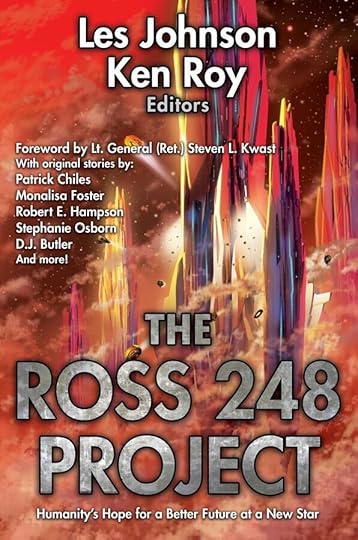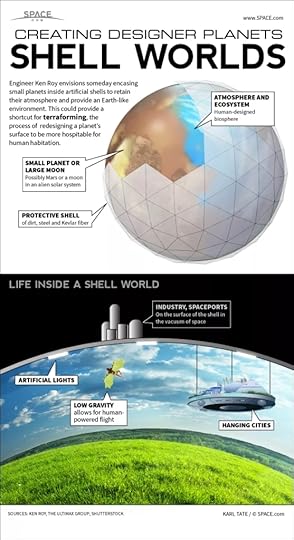Matthew S. Williams's Blog, page 11
February 17, 2023
The Ross 248 Project eARCs are now Available!

That’s right! The Electronic Advanced Reader Copies (eARCs) of The Ross 248 Project are now available for Kindle and in other e-formats. This anthology contains scientific essays and science fiction stories that explore how humans may one day live on plants that orbit Red Dwarf suns. The volume is edited by famed NASA scientists and SF author Les Johnson and terraforming specialist Ken Roy – who coined the idea for “Shellworlds” (see graphic below).
My own contribution was an essay titled “Terraforming Planets Under a Red Sun,” which reviews the relevant science and ecological engineering behind terraforming, how it could be used to transform planets and moons in our Solar System, and how this might be applied to exoplanets as well. This summer, I will be joining Johnson and Roy on a panel that discusses the new book at the 8th Interstellar Symposium: “In the Light of Other Suns.” This will event is taking place at McGill University, Montreal, from July 10th – 13th and is being hosted by the Trottier Institute for Research on Exoplanets (iREx).
And if you’re in Montreal that week, swing on by! We’ll grab some smoked meat and beers!
And be sure to check out The Ross 248 Project over at Baen.com or pre-order the paperback at Simon & Schuster!

February 12, 2023
Episode Twenty-Eight of Stories from Space – “The Enduring Influence of 2001: A Space Odyssey” – is now Live!
This week’s episode is dedicated to what is arguably the most influential and inspired science fiction film of all time. The movie and novelization of 2001: A Space Odyssey were released simultaneously in 1968 and had a massive impact on audiences and cinematic history. It combined hard science, futuristic predictions, and cosmology with inspired ideas about extraterrestrials, evolution, and classic philosophy. It also combined Arthur C. Clarke’s knowledge and predictive powers with Stanley Kubrick’s famous “show, don’t tell” style of filmmaking.
But there are several lesser-known facts about the film that have to do with its inspiration and production. In addition to being a consultant and co-author on the script, the film was based on two of Arthur C. Clarke’s short stories – “The Sentinel” and “Encounter at Dawn.” There’s also the way Kubrick struggled to find a realistic depiction of advanced extraterrestrials. Carl Sagan was brought in to advise Kubrick on this, and (middle, middle, middle) the Monolith was born! Check it out below:
Where to Listen: Simplecast Apple Podcasts Spotify Amazon MusicFebruary 9, 2023
Episode Twenty-Seven of Stories from Space, “The Starry Messenger: Galileo Galilei,” is Now Live!
This week’s episode is dedicated to the life and times of Galileo Galilei. In 1610, using a telescope of his own make and design, Galileo forever revolutionized astronomy as we know it. Not only did he prove the Copernican model (aka. the heliocentric model) of the Universe to be correct. His observations of the Sun, Moon, Jupiter’s moons, Mars, and the Milky Way effectively demonstrated that Earth was neither special nor unique in the Universe.
Galileo was a rare sort, a polymath, an intellectual giant, and a passionate soul. In that respect, his life and accomplishments are comparable only to individuals like Ptolemy, Copernicus, Newton, Einstein, and Hawking. While he didn’t get his due in his lifetime, history remembers Galileo for his efforts to break humanity out of provincially-minded dogma. That struggle continues today, and it’s good to honor and acknowledge those who contributed along the way.
Where to Listen:SimplecastApple PodcastsSpotifyAmazon MusicJanuary 28, 2023
Episode Twenty-Six of Stories from Space, “The Copernican Revolution,” is Now Live
This week’s episode focuses on the life and times of Nicolaus Copernicus, the famed Rennaissance Polish astronomer who proposed the heliocentric model of the Universe. The details of this model were presented in his magnum opus, On the Revolutions of the Heavenly Spheres, which Copernicus had published in 1543 when he was on his deathbed. While Copernicus is a household name and the basics of his model are well-known, the story of how he came to his grand realization is less well-known.
The heliocentric model was inspired by thousands of years of observations and calculations by astronomers. These included several pre-Socratic Greek philosophers that were lost to Europeans (but preserved by Muslim scholars) and scholars from West Asia, Iran, India, and Al-Andusa (Spain before the Reconquista). These sources contradicted the prevailing models of Aristotle and Ptolemy, both of whom were considered canon in Europe and Eurasia.
By synthesizing these observations with his own calculations, Copernicus showed how Earth and the other planets orbited the Sun, how the Moon orbited Earth, and how Earth rotated. In short, he synthesized and crystallized one of the most profound scientific discoveries ever made, one that was thousands of years in the making. And in so doing, he forever revolutionized our understanding of the cosmos and our place in it.
In fact, his observation that the Sun was NOT at the center of the Universe began a long process where humans began to realize that neither they nor Earth were unique in the cosmos. As Sagan put it: “One of the distinctions and triumphs of the advance of science has been the deprovincialization of our worldview.” Because of Copernicus’s role in this, the scientific axiom that states that humanity is NOT in a special or privileged position to view the cosmos is known as the Copernican Principle.
Where to Listen:
Simplecast Apple Podcasts Spotify Amazon MusicJanuary 14, 2023
Episode Twenty-Five of Stories from Space is now Live!
This week, I had the privilege of chatting with famed physicist, author, NASA technologist, and interstellar travel expert Les Johnson. In addition to discussing the challenges of mounting human-rated missions to interstellar space, we talked about his science fiction writing – which includes multiple novels and anthologies. He’s also been a contributor and the chief editor of several collections that combine SF short stories with scientific essays, like Going Interstellar and Stellaris: People of the Stars,
We also talked about the upcoming anthology, The Ross 248 Project, which is available for pre-order through Baen Publishing and Simon & Schuster. This book explores how human beings could one day travel to rocky planets that orbit Red Dwarf suns and how these planets could be terraformed to make them habitable for Earth organisms (including us). I had the honor of contributing an essay to this anthology, “Under a Crimson Sun,” which discusses potential terraforming strategies and was inspired by a series I wrote for Universe Today (The Definitive Guide to Terraforming). Follow the links below to check it out!
Where to Listen: Spotify Apple Podcasts Amazon Music SimplecastEpisode Twenty-Four of Stories from Space is now Live!
This week’s episode is a homage to one of the greatest science fiction authors and science communicators of all time: Arthur C. Clarke. In addition to his writing and research, Clarke was a noted futurist who made many famous predictions about the future. His ability to anticipate technological advancements and the effect they would have on society earned him the nickname “Prophet of the Space Age.”
The subject of his predictions and what he got right or wrong is something I’ve been examining since I read the novelization of 2001: A Space Odyssey a few decades ago. While there were many details that he got wrong and had to ret-con in later books, he was eerily right about many things. These included communication satellites, the internet, spaceplanes, commercial spaceflight, and orbital space stations. Follow the links below to hear more!
Where to Listen:SpotifyApple PodcastsAmazon MusicSimplecastJanuary 6, 2023
Episode Twenty-Three of Stories from Space is now Live!
For this week’s episode, I sat down with Dr. Alex Ellery, a professor of Mechanical and Aerospace Engineering at Carleton University – which happens to be my alma mater (Go Ravens!) Dr. Ellery has written extensively about a subject that is near and dear to the heart of SETI researchers – Von Neumann Probes! For those unfamiliar, the concept is named in honor of famed scientist and engineer John Von Neumann (1903-1957).
In a series of lectures and his posthumously-published book, Theory of Self Reproducing Automata, he described machines that could harvest raw materials and produce exact copies of themselves. Over time, this notion has merged with ideas like nanotechnology and additive manufacturing (3-D printing) to become an idea for space exploration. And as SETI reminds us, if we can think of it, someone else has likely created it already.
Since the 1970s, Von Neumann probes have become a focal point in the ongoing debate about the existence of extraterrestrial intelligence (aka. the Fermi Paradox). The argument goes like this: if an advanced civilization were out there, we’d see evidence of self-replicating probes by now. This argument has led to all kinds of speculation and theories, and you can bet that Ellery and I got into them with gusto! Follow the links below to have a listen!
Where to Listen:SpotifyApple PodcastAmazon MusicSimplecastDecember 24, 2022
Episode Twenty-Two of Stories from Space is now Live!
This week was a bit of a departure. In honor of Christmas, I decided to dedicate this episode to the life and times (and accomplishments) of Sir Isaac Newton. Why? Simple! Because Sir Isaac Newton was born on December 25th, 1642 (Julian Calendar), which works out to January 3rd, 1643 today (Gregorian Calendar). Also because I am doing an ongoing segment where I talk about the most influential people in the fields of astronomy and the sciences.
And when it comes right down to it, Newton’s contributions to these various fields (according to countless polls) are comparable only to those of Einstein. But what made his contributions so significant was the way he synthesized the work of previous generations and scientists. Or, as Newton himself put it: “If I have seen further, it is by standing on the shoulders of giants.”
Where to Listen:
Spotify Apple Podcasts Amazon Music SimplecastDecember 19, 2022
Episode Twenty-One of Stories from Space is now Live!
This week, I sat down with legendary science communicator and educator Janet Ivey. Janet is the Governor of the National Space Society (NSS). the creator and CEO of Explore Mars, a NASA Science Ambassador, a TV/film personality, and the creator and host of Janet’s Planet. We talked about space exploration, its potential to unite and inspire, and what it’s like to bring that to the next generation of spacers!”
\We also got into what it’s like being a woman in what is still a “boy’s club” and how rewarding it is to inspire the next generation of women to pursue a career in space and the STEMs. Check out the episode below:
Where to Listen: Spotify Apple Podcasts Amazon Music SimplecastDecember 14, 2022
Episode Twenty of Stories from Space is now Live!
This week’s guest was astrophysicist, science communicator, and author Ethan Siegel. Ethan has been a professor of astrophysics at multiple universities, a senior contributor to Forbes magazine (ever heard of it?), and their chief science writer. He is also the producer of Starts with a Bang, a podcast and column where he talks about the Big Bang and other big questions related to cosmology.
His books include Trekology, which explores the technical aspects of the famous Star Trek franchise; Beyond the Galaxy, an examination of humanity’s growing awareness of the Universe; and the upcoming Encyclopaedia Cosmologica, a richly-illustrated and plainly-explained origin story about the cosmos.
During our chat, we got into multiple topics, including the greatest mysteries facing astronomers and cosmologists today, the James Webb naming controversy, and what makes astrophysics and science communication so exciting! Take a listen and be sure to check out Ethan’s podcast, articles, and websites.
Where to Listen:
SpotifyApple PodcastsAmazon MusicSimplecast


